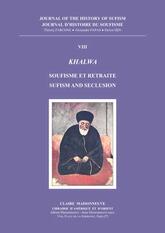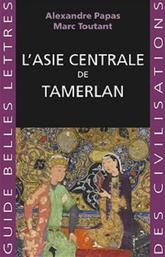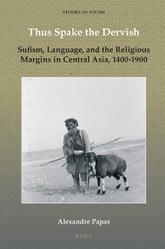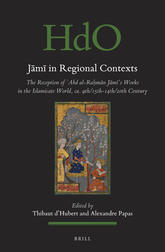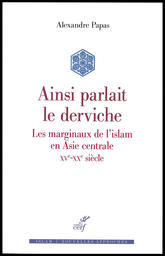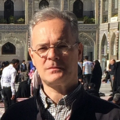
Alexandre Papas
Chercheur.e statutaire
Directeur de recherche, Directeur d'études de l'EPHEInstitution de rattachement principal : Directeur du Centre d’études ottomanes au Collège de FranceInstitution(s) de rattachement : CNRS, EPHE
Equipe(s) : Asie centrale et Caucase
Coordonnées professionnelles
Centre d’études ottomanes
Collège de France
52, rue du Cardinal Lemoine
75005 Paris
alexandre.papas[at]college-de-france.fr
papas.5@orange.fr
alexandre.papas@ephe.psl.eu
https://www.ephe.psl.eu/alexandre-papas
Né en 1973, Alexandre Papas est historien du monde turc et de la mystique musulmane, diplômé en philosophie de l’université Paris IV-Sorbonne, en persan, en turc et en mongol de l’INALCO, et docteur en histoire de l’EHESS (2004 ; prix de la meilleure thèse de l’Institut d’études de l’islam et des sociétés du monde musulman attribué en 2006). Ses recherches portent essentiellement sur la mystique soufie, le culte des saints et les questions politico-religieuses en Asie centrale et dans l’Empire ottoman du XVe siècle à nos jours. Il est chargé de recherche au CNRS depuis octobre 2007 et directeur de recherche depuis octobre 2017 ; il a été maître de conférences invité à l’université de Kyoto (été 2007), à l’Ohio State University (hiver-printemps 2008) et à l’American University of Paris (printemps 2009). Il a obtenu la médaille de bronze du CNRS en 2012. Depuis 2022, il est directeur d’études cumulant à l’EPHE, section des sciences historiques et philologiques.
Il codirige la collection « Handbook of Sufi Studies » :
https://brill.com/view/serial/HO1-HSUF
Il est rédacteur en chef du Journal of Sufi Studies :
https://brill.com/view/journals/jss/jss-overview.xml?language=en
Born in 1973, Alexandre Papas is a historian of the Turkish world and the Islamic mysticism. He graduated in philosophy at the Sorbonne University, and holds diplomas in Persian, Turkish and Mongolian from the Institute of Oriental Languages & Civilizations, and a PhD in history from the EHESS in 2004. In 2006, he received the award of Best PhD Dissertation from the Institute for the Study of Islam and Societies of the Muslim World. His work deals mainly with Sufism, saint veneration and politico-religious issues in Central Asia and the Ottoman Empire from the 15th century to present. He is a research fellow at the CNRS since October 2007 and senior research fellow since October 2017. He has been a visiting assistant professor at the Kyoto University (summer 2007), the Ohio State University (winter and spring 2008) and the American University of Paris (spring 2009). In 2012, he has been awarded the CNRS Bronze Medal for Modern History. Since 20222, he is professor at EPHE, Department of philology and history.
He is co-editor of the “Handbook of Sufi Studies” series:
https://brill.com/view/serial/HO1-HSUF
He is the executive editor of the Journal of Sufi Studies:
https://brill.com/view/journals/jss/jss-overview.xml?language=en
Comités de rédaction ou de lecture / Editorial and advisory boards
· Archives de sciences sociales des religions
· Anthropology of the Contemporary Middle East and Central Eurasia
· Bulletin critique des annales islamologiques
· Journal d’histoire du soufisme
· Zia-e-Tahqeeq (Pakistan)
· Teosofi: Jurnal Tasawuf dan Pemikiran Islam(Indonésie)
Terrains / Fieldwork areas
· Asie centrale / Central Asia
· Empire ottoman / Ottoman empire
· Chine de l’Ouest (Xinjiang, Qinghai, Gansu) / Northern China
· Inde du Nord et Pakistan / Northern India and Pakistan
Thèmes et projets de recherches / Areas of specialization
· Histoire de l’islam et du soufisme / History of Islam and Sufism
· Hétérodoxie musulmane / Muslim heterodoxy
· Littératures ottomane et chaghatay / Ottoman and Chaghatay literature
· Manuscrits turcs / Turkish manuscripts
· Relations entre islam et politique / Islam and politics
· Les minorités musulmanes de Chine et du Tibet / Muslim minorities in China and Tibet
Bibliographie / Publications
Livres / Books
1. Soufisme et politique entre Chine, Tibet et Turkestan : étude sur les Khwajas Naqshbandis du Turkestan oriental, Paris, Jean Maisonneuve, 2005, iii-291 p.
2. Mystiques et vagabonds en Islam : portraits de trois soufis qalandar, Paris, Cerf, 2010, 339 p.
3. Voyage au pays des Salars (Tibet oriental, début du XXIe siècle), Paris, Cartouche, 2011, 157 p.
4. Ainsi parlait le derviche. Les marginaux de l’islam en Asie centrale (XVe-XXe siècle), Paris, Cerf, 2018, 362 p.
5. Trad. anglaise Thus Spake the Dervish: Sufism, Language, and the Religious Margins in Central Asia (15th-20th Centuries), Leyde, Brill, 2019, ix-230 p.
6. L’Asie centrale de Tamerlan (XIVe-XVe siècle), Paris, Belles Lettres, 2022, 320 p. (avec Marc Toutant)
7. Les Empires turks. De l’Altaï à l’Anatolie (VIe-XIVe siècle), Paris, Belles Lettres, en préparation (avec Marc Toutant)
Livres édités / Edited volumes
1. Central Asian Pilgrims: Hajj Routes and Pious Visits between Central Asia and the Hijaz, Berlin, Klaus Schwarz-Ifeac, 2011, 331 p. (avec Thomas Welsford et Thierry Zarcone)
2. L'Autorité religieuse et ses limites en terres d'islam : approches historiques et anthropologiques, Leyde, Brill, 2013, x-277 p. (avec Nathalie Clayer et Benoît Fliche)
3. Family Portraits with Saints: Hagiography, Sanctity and Family in the Muslim World, Berlin, Klaus Schwarz-Ehess, 2013, 462 p. (avec Catherine Mayeur-Jaouen)
4. Jāmī in Regional Contexts: The Reception of ʿAbd al-Raḥmān Jāmī’s Works in the Islamicate World, Leyde, Brill, Handbook of Oriental Studies, 2018, xviii-870 p. (avec Thibaut d’Hubert)
5. Sufi Institutions, Leyde, Brill, Handbook of Sufi Studies, 2020, xv-442 p.
6. Sufi Texts in Translation, double numéro spécial du Journal of Sufi Studies, 10, 2021, 254 p. (avec Amer Latif et Mohammed Rustom)
7. Sufi Material Culture, Leyde, Brill, Handbook of Sufi Studies, en préparation (avec Thierry Zarcone).
Humanités numériques / Digital humanities
1. Annotated Turki Manuscripts from the Jarring Collection Online:
https://uyghur.ittc.ku.edu/manuscripts/index.xhtml
2. A Handbook of Chaghatay manuscript transcription:
https://uyghur.ittc.ku.edu/manuals/ManuscriptsTranscription.xhtml
Articles dans des revues à comité de lecture / Journal articles
1. « La Makhfî ‘ilm ou Science secrète de ‘Alî Shîr Nawâ’î : le projet d’une langue mystique naqshbandî », Journal d’histoire du soufisme, 3, 2002, p. 229‑255.
2. « Soufis du Badakhshân : un renouveau confrérique entre l’Inde et l’Asie centrale », Cahiers d’Asie centrale, 11, 2003, p. 87‑102.
3. « “Dansez et chantez” : le droit au samâ‘ selon Âfâq Khwâja, maître naqshbandî du Turkestan (xviie siècle) », Journal d’histoire du soufisme, 4, 2004, p. 189‑200.
4. « The Sufi and the President in Post-Soviet Uzbekistan », ISIM Review,16, 2005, p. 38‑39.
5. « Soufisme, pouvoir et sainteté en Asie centrale : le cas des Khwâjas de Kashgarie (xvie‑xviiie siècles) », Studia Islamica, 100/101, 2005, p. 161‑182.
6. « L’histoire et les sciences sociales à l’épreuve de l’Asie centrale : à propos d’un récent numéro des Annales », Turcica, 37, 2006, p. 365‑375.
7. « Un manuscrit inconnu à propos des soufis de Kashgarie conservé à la Bibliothèque nationale Firdawsi (Tadjikistan), Studia Iranica, 35, 2006, p. 97‑108.
8. « Toward a New History of Sufism: the Turkish Case », History of Religions, 46/1, 2006, p. 81‑90.
9. « Notes sur la Naqshbandiyya Mujaddidiyya en Asie centrale chinoise (xviiie‑xixe siècles) », Journal d’histoire du soufisme, 5, 2007, p. 319‑328.
10. « Shaykh Succession in the classical Naqshbandiyya: Spirituality, Heredity and the Question of Body », Journal of Asian and African Area Studies, 7/1, 2007, p. 36‑49.
11. « Les tombeaux de saints musulmans au Xinjiang : culte, réforme, histoire », Archives de sciences sociales des religions, 142, 2008, p. 47‑62.
12. « Fonctionnaires des frontières dans l’Empire mandchou : les beg musulmans du Turkestan oriental (1760‑1860) », Journal asiatique, 296/1, 2008, p. 23‑57.
13. « No Sufism without Sufi orders: Rethinking Tarîqa and Adab with Ahmad Kâsânî Dahbidî (1461‑1542) », Kyoto Bulletin of Islamic Area Studies, 2/1, 2008, p. 4‑22.
14. « Beyond the Khanate and the Caliphate: the Ishanate of Âfâq Khwâja in Seventeenth Century Eastern Turkestan », Études orientales, 25, 2008, p. 53‑67.
15. « Joining the Dots between the Khwājas of East Turkestan: A Shajara Scroll Preserved at the Louvre Museum », Der Islam, 88, 2012, p. 352-365.
16. « Un rouleau talismanique du Xinjiang musulman », Eurasian Studies, 12, 2014, pp. 555-660, xiv-xxvi.
17. « Kharābātī (1638-1730), un poète populaire du Turkestan oriental », Cahiers d’Asie centrale, 24, 2015, p. 127-144.
18. « Creating a Sufi Soundscape: Recitation (dhikr) and Spiritual Audition (samā‘) according to Ahmad Kāsānī Dahbidī (d. 1542) », Performing Islam, special issue “Islamic Soundscapes of China” (éd. R. Harris), 3/1-2, 2015, p. 23-41.
19. « L’histoire du soufisme à Multan (Pakistan), nouvelles données », Journal of the History of Sufism, 7, 2018, p. 199-228. (avec Muhammad Touseef)
20. « The History of Sufism in Multan: New Data from the Urdu Tadhkirah Tradition », Islamic Studies, 58/4, 2020, p. 471-501. (avec Muhammad Touseef)
21. « Neo-Traditional Sufism: the Books, the Shrine and the Relics of Sufi Barkat Ali in Faisalabad, Pakistan », Kyoto Bulletin of Islamic Area Studies, 13, 2020, p. 14-30. (avec Ghulam Shams-ur-Rehman)
22. « The Dalâ’il al-khayrât in Central Asia and Eastern Turkestan: Some Research Leads », Journal of Islamic Manuscripts, 12/3-4, 2021, p. 475-500.
23. « Le Traité de la rosace (Risāle-i gül-ābād) d’Ibrāhīm el-Eşrefī el-Qādirī, cheikh soufi ottoman du XIIe/XVIIIe siècle », Journal of Sufi Studies, 10/1-2, 2021, p. 141-151.
Chapitres d’ouvrages collectifs / Chapters in collective volumes
1. « Une représentation textuelle de la ville : sur un registre urbain du Turkestan chinois (1306/1889‑90) », in éd. F. Richard & M. Szuppe, Écrit et culture en Asie centrale et dans le monde turco-iranien, xe‑xixe siècles, Paris, Peeters-Cahiers Studia Iranica, 40, 2009, p. 93‑109.
2. « Refonder plutôt que réformer : la Naqshbandiyya non mujaddidî dans le monde turc (xvie‑xviiie siècles), lecture de trois textes naqshbandî kâsânî », in éd. R. Chih et C. Mayeur-Jaouen, Le Soufisme à l’époque ottomane (xvie‑xviiie siècle), Le Caire, Ifao, 2010, p. 235‑248.
3. « So close to Samarkand, Lhasa: Sufi Hagiographies, Founder Myths and Sacred Space in Himalayan Islam », in éd. A. Akasoy, Ch. Burnett et R. Yoeli-Tlalim, Islam and Tibet: Interactions along the Musk Routes, Farnham, Ashgate, 2010, p. 261‑279.
4. « Following Abdurreşîd Ibrâhîm, a Tatar globetrotter on the way to Mecca », in éd. A. Papas, Th. Welsford et Th. Zarcone, Central Asian Pilgrims: Hajj Routes and Pious Visits between Central Asia and the Hijaz, Berlin, Klaus Schwarz-Ifeac, 2011, p. 199‑221.
5. « Islamic Brotherhoods in Sixteenth Century Central Asia: the Dervish, the Sultan, and the Sufi Mirror for Princes », in éd. N. Terpstra, A. Prosperi et S. Pastoria, Faith’s Boundaries: Laity and Clergy in Early Modern Confraternities, Turnhout, Brepols, 2012, p. 209-231.
6. « Voyageurs ottomans et tatars en Extrême-Orient : un dialogue entre islam, confucianisme et lamaïsme », in éd. E. Kaynar et N. Clayer, Penser, agir et vivre dans l'Empire ottoman et en Turquie. Études réunies pour François Georgeon, Paris, Peeters, 2013, p. 217-229.
7. « When the Dervish Starts Publishing: a Note on Renunciation and Literary Production in the Indian Qalandariyya », in éd. R. Chih, D. Gril, C. Mayeur-Jaouen et R. Seesemann, Sufism, Literary Production and Printing in the Nineteenth Century, Wurtzbourg, Ergon, 2015, p. 121-138.
8. « The Son of his Mother: Qalandarī Celibacy and the “Destruction” of Family », in éd. C. Mayeur-Jaouen et A. Papas, Family Portraits with Saints, 2013, p. 420-444.
9. « Sufi Lineages among the Salars: an Overview », in éd. M.‑P. Hille, B. Horlemann et P. K. Nietupski, Muslims in Amdo Tibetan Society. Multidisciplinary Approaches, Lanham, Lexington Books, 2015, p. 109-134. (avec Ma Wei)
10. « Vagrancy and Pilgrimage According to the Sufi Qalandari Path », in éd. M. Boivin et R. Delage, Devotional Islam in Contemporary South Asia. Shrines, Journeys and Wanderers, Londres, Routledge, 2015, p. 15-30.
11. « Cheikhs et sultans en Asie centrale au XVIe siècle : Une analyse de la Risâla-yi tanbîh al-salâtîn d’Ahmad Kâsânî Dahbidî », in éd. N. Clayer, A. Papas et B. Fliche, L’autorité religieuse et ses limites en terres d’islam. Approches historiques et anthropologiques, Leyde, Brill, 2013, p. 11-31.
12. « Muslim Reformism in Xinjiang: Reading the Newspaper Yengi Hayat (1934‑1937) », in éd. I. Bellér-Hann, B.N. Schlyter et J. Sugawara, Kashgar Revisited. Uyghur Studies in Memory of Ambassador Gunnar Jarring, Leyde, Brill, 2016, p. 161-183.
13. « Tugh : un transfert culturel dans l’islam du Xinjiang », in éd. M. Espagne et alii, Transferts culturels par l’Asie centrale. Actes du colloque de Samarcande, 12-14 septembre 2013, Paris-Samarcande, IICAS, 2013, p. 208-216.
14. « Promoting Saints and Mazars in the Tarim Basin: the Religious Policy of Afaq Khwaja in Seventeenth Century and its Consequences up to the Contemporary Era », in éd. Y. Shinmen, M. Sawada et E. Waite, Muslim Saints and Mausoleums in Central Asia and Xinjiang, Paris, J. Maisonneuve, 2013, p. 39-52.
15. Préface de Marc Toutant, Un empire de mots. Pouvoir, culture et soufisme à l’époque des derniers timourides au miroir de la Khamsa de Mīr ‘Alī Shīr Nawā’ī, Paris, Peeters, 2016, p. xxix-xxxii.
16. « Dog of God: Animality and Wildness among Dervishes », in éd. Sh. Raei, Islamic Alternatives. Non-Mainstream Religion in Persianate Societies, Wiesbaden, Harrassowitz, 2017, p. 121-138.
17. « Individual Sanctity and Islamization in the ṭabaqāt Books of Jāmī, Navāʾī, Lāmiʿī, and Some Others », in éd. Th. D’Hubert et A. Papas, Jāmī in Regional Contexts: The Reception of ʿAbd al-Raḥmān Jāmī’s Works in the Islamicate World,Leyde, Brill, Handbook of Oriental Studies, 2018, p. 378-423.
18. « Lingua Franca or Lingua Magica? Talismanic Scrolls from Eastern Turkistan », in éd. N. Green, The Frontiers of Persian Learning: Testing the Limits of a Eurasian Lingua Franca, 1600-1900, Berkeley, California University Press, 2019, p. 207-222.
19. « Introduction: What is a Sufi Institution? », in éd. A. Papas, Sufi Institutions, Leyde, Brill, Handbook of Sufi Studies, 2020, p. 1-24.
20. « Sufism and Worldly Powers », in éd. A. Papas, Sufi Institutions, Leyde, Brill, Handbook of Sufi Studies, 2020, p. 255-291.
21. « The Khāksār Shi‘i Sufi order: an updated introduction », in éd. D. Hermann et M. Terrier, Shi‘i Islam and Sufism. Classical Views and Modern Perspectives, Londres, Institute of Ismaili Studies, 2020, p. 291-304.
22. « Bombay Mystical City: Muslim Shrines and Saints in the Urban Fabric from 1800 to Present », in éd. D. Ephrat, E. S. Wolper et P. G. Pinto, Saintly Spheres and Islamic Landscapes: Emplacements of Spiritual Power across Time and Place, Leyde, Brill, 2020, p. 335-365.
23. « Mi‘râciyye: The Ascension of the Prophet in Ottoman Literature (15th-20th c.) », in éd. D. Gril, S. Reichmuth et D. Sarmis, The Presence of the Prophet in Early Modern and Contemporary Islam, Leyde, Brill, 2021, p. 460-498.
Articles d’encyclopédie / Encyclopaedia articles
1. « Dervish », Encyclopaedia of Islam, 3e éd., Leyde, Brill, 2011, vol. 4, p. 129‑136.
2. « Abu Tahir al-Samarqandi », Encyclopaedia of Islam, 3ème éd., Leyde, Brill, 2013, vol. 2, p. 137-138.
3. « Antinomianism (ibāḥa, ibāhiyya) », Encyclopaedia of Islam, 3ème éd., Leyde, Brill, 2014, vol. 2, p. 22-27.
4. « Chine », in F. Georgeon, N. Vatin et G. Veinstein, Dictionnaire de l’Empire ottoman, Paris, Fayard, 2015, p. 258-259.
5. « Central Asia and China », Oxford History of Islam-Oxford Islamic Studies Online, New York, Oxford University Press, 2016, en ligne.
6. « Initiation in Sufism », Encyclopaedia of Islam, 3ème éd., Leyde, Brill, 2018, vol. 6, p. 101-105.
7. « Hagiography, Persian and Turkish », Encyclopaedia of Islam, 3ème éd., Leyde, Brill, 2018, vol. 6, p. 65-69.
8. « Khojas of Kashgar », Oxford Research Encyclopaedia of Asian History, New York, Oxford University Press, 2018, en ligne.
9. « Khānaqāh », Encyclopaedia of Islam, 3ème éd., Leyde, Brill, 2020, p. 74-83.
10. « Malang », Encyclopaedia of Islam, 3ème éd., Leyde, Brill, 2020, p. 117-120.
11. « Fakir», Encyclopaedia of Islam, 3ème éd., Leyde, Brill, 2021, p. 22-24.
12. « Multani, Khuda Bakhsh », Encyclopaedia of Islam, 3ème éd., Leyde, Brill, 2021, p. 135-138. (avec Muhammad Touseef)
13. « Multani, ‘Ubaydullah », Encyclopaedia of Islam, 3ème éd., Leyde, Brill, 2021, p. 138-139. (avec Muhammad Touseef)
14. « Sufi Orders », Encyclopaedia of Islam, 3ème éd., Leyde, Brill, sous presse.
Articles pour le grand public / Articles for general readership
1. « On Ancient Central Asian Tracks », Steppe, 4, 2008, p. 50‑79. (avec Lisa Ross)
2. « Pilgrimages to Muslim Shrines in Western China », in Lisa Ross et alii, Living Shrines of Uyghur China, New York, Monacelli Press, 2013, p. 11-17.
3. « Turcs et Mongols », Atlas des peuples, Paris, Le Monde, 2018, p. 50-53.
4. « La realta divina, scopo del cammino sufi », Oasis, 29, 2019, p. 39-48.
Enseignements / Teaching
« Initiation au turc ottoman ». Cours, EPHE, Sorbonne, tous les jeudis de 9h à 10h, annuel.
« Études turques et ottomanes ». Séminaire, EPHE, Sorbonne, tous les jeudis de 10h à 12h, annuel.
« Lecture de sources de l’aire turco-persane : introduction au turc tchaghatay (XV-XXe s.) » avec Marc Toutant. Séminaire, INALCO, 2nd semestre.
Entretiens / Interviews
https://www.franceculture.fr/personne-alexandre-papas.html-0
https://www.weghurstories.com/episode-8
https://blog.brill.com/humanitiesmatter/interview_papas.html
https://www.rfa.org/uyghur/xewerler/derwishler-06152020182314.html
https://www.rfa.org/uyghur/xewerler/derwishler-08102020135033.html
https://www.lavie.fr/actualite/societe/soufis-derviches-sur-la-trace-des-vrais-fous-dallah-6100.php
https://www.facebook.com/photo/?fbid=586193740019635&set=ecnf.100058870428562
https://www.cairn.info/revue-monde-chinois-2021-1-page-103.htm
